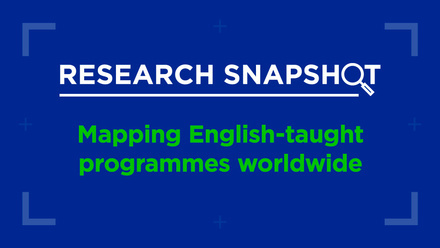7 challenges to becoming data-driven

Each year universities seem to need to make more and more decisions, from the simplest ones such as where to recruit the next cohort of students, to more complex ones such as which new courses to introduce or how to internationalise. Data can play an important role in informing these decisions.
While it is quick and therefore tempting to base some of the decision-making on your ‘gut feeling', this approach can often backfire, due to unconscious biases and wrong or missing information. Additionally, it can be difficult to get buy-in from senior management and academic staff if there is no ‘evidence’ to support recommendations. Some of the decisions we need to make on a regular basis in international education also have a hefty price tag attached to them, from straightforward financial investments or reputation risks, to missed opportunities or simply staff time spent focusing on the wrong strategy. And no one wants to be blamed for making the wrong decision.
Therefore, basing strategic choices solely on your experience can be tricky, especially given how the world moves faster and faster and things can change in a matter of days. So there you are, left with the latest trend everyone keeps on talking about: data-driven strategic decision-making, a fancy wild creature that everyone wants to own, but not many know how to tame!
Taming the data beast
We should also first clarify that using data for decision-making is not a black-and-white dichotomy, but rather that universities go through various stages of using data, from being first data apathetic to becoming more data aware and capturing more data themselves (eg for measuring performance). Later they are able to move towards being more data critical when they are developing more sophisticated approaches to using data for critical decisions (eg introducing new programmes, choosing focus countries). In the end, everyone’s dream is to truly become data-driven, where they start thinking data-first and everyone is working together to use data as efficiently as possible in all their work.
However, as you decide to go for it and make the use of data to inform your strategy choices and achieve your goals, you have to learn and be thorough and smart about using data. Along the way, you’ll likely face one or more of these seven challenges.
1. You have data – now what?
Let’s say you get yourself a beautiful interesting dataset, with nice visualisations, pretty graphs, great correlations and even high validity. You’ve even started collecting some CRM data, you know the number of your student applications and you even have your Google Analytics certification. Amazing!
Now what? Sadly, universities often stop at acquiring data, getting stuck in the data aware stage, and then don’t take the next steps of analysing it and interpreting what they see. Analysis is where magic happens, and data turns into insights. It’s where you see patterns, spot trends, make sense of the numbers in front of you, and start drawing some conclusions or making predictions.
2. Do you have the right tools?
While many universities (especially those in the data aware stage) focus on capturing data – for example through their CRM, Google Analytics or internal financial reporting – often what they end up using to analyse all this data is good old Excel. While a versatile tool, frequently Excel will not be able to take your data to the next level. Especially when we start talking about huge datasets, then you’ll need to invest in the right tools, including data visualisation and analysis tools like Tableau, Power BI, SQL, QlikView, RapidMiner, KNIME, alteryx and others.
3. Data doesn’t replace critical thinking
There is a lot of value in data, but to make sense of it, you still need a human touch, and not everyone has the data skills to ask critical questions, such as:
- Where does the data come from?
- Are there biases in the data?
- How much can I trust the data?
- What would be a reliable sample size?
- Am I noticing a correlation or a causation?
Making these judgements and being able to ask the right questions is crucial when progressing towards becoming data critical as is knowing which data sources to employ to support appropriate decision-making in your university.
4. What is my research question?
One of the first pitfalls we see, especially when moving towards the data-driven stage, as more people become aware of data and want to use it to make decisions, is that everyone spends more and more time looking at data. However, without a research question in mind, especially when you have a wide variety of tools and datasets, it can be easy to get lost in all the options, and reach a sort of decision paralysis. Starting with a research question and hypothesis in mind is valuable for making better decisions and knowing which tools to use. Data is useless if it doesn’t serve a purpose.
5. What does it all mean?
Data can be deceiving sometimes, so do look at it from different angles. Sometimes it means literally asking different people to look at the same diagram, answer the same questions and explain their reasoning. You will be surprised at the amount of logical-sounding possible answers from just a simple dataset! There is always more than one way to look at a problem, so make sure you’ve considered all the options.
6. The bigger context
While data can help you spot various trends and answer interesting questions, it never holds all the answers. Especially for people in international education, understanding the bigger context is one of the most important skills when interpreting data: knowing how national policies are influencing international mobility, understanding changes to tuition fees, national currency fluctuations, visa policies and so on. Making sense of data in international education often also means understanding its dynamics.
7. Enjoying the learning process
Last and possibly the most important – enjoy it! Analysing data from different angles and making sense of numbers can be fun. It makes you feel like a detective searching for the truth, seeking right answers and better strategic decisions. Plus, you’re improving your own skills and career opportunities because data skills are in such high demand now. And no worries – being geeky is cool these days!
Overall, as more universities are moving towards becoming more data-driven, we can only rejoice. It means our industry will get a better understanding of the many interconnected factors that matter in international education and be able to make decisions based not on what we think might work, but on facts. In the long run this means better-run universities that find it easier to achieve their strategic goals, enabling them to better serve their communities, faculty and students better than ever.






